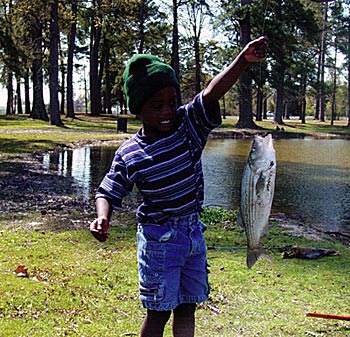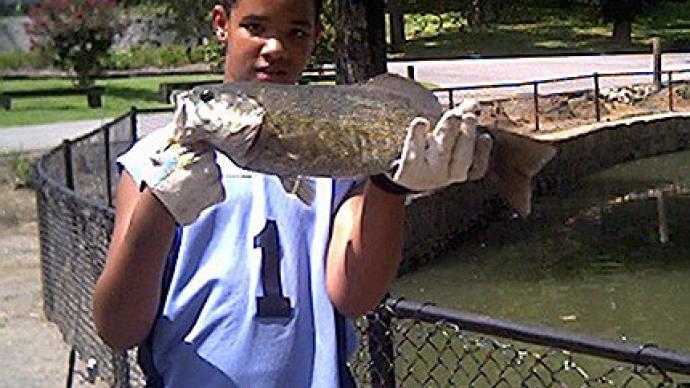
Maybe I am a little biased, but there really is no better way to bond as a family than to go fishing together. Whether you are watching your child land their first fish or if you are helping a child you just met bait a hook for the first time, there is something deeply personal and forever about the experience. Fishing as an activity is fun and can make lasting memories. Passing down your passion for fishing to friends and family is rewarding in these and many other intangible ways. While these bonds and memories created by taking children fishing cannot be overstated, creating new anglers has another critically important purpose—the future of conservation depends on it!
Fishing has enjoyed being one of the most popular outdoor recreational activities in the United States for many decades. Still, this status has been slipping away as more and more competing opportunities arise. As a result, fishing participation in recent decades has been stagnant or declining in many regions, and currently, only about 14% of the public fishes (Figure 1). As an angler, my initial response to this decline is to celebrate—fewer anglers equal less competition for my favorite fishing holes—but as a fisheries manager, I realized the extreme danger of a declining angler base. Here are the three main reasons why.
1. Fishing is good for local economies. For example, in 2016, 35.8 million people aged 16 or older participated in fishing, spending an average of 13 days on the water and $46.1 billion on equipment, licenses, trips, and other fishing-related items or events. These expenditures represent a significant financial windfall for local and state economies. As the number of people fishing declines, the communities that depend on angling revenues will suffer.
2. Anglers are responsible for most of the funding for fish conservation and aquatic habitat restoration that state fish management agencies conduct. The primary sources of direct fish conservation funding in the United States come from the sale of fishing licenses and excise taxes collected on fishing-related expenditures under the Federal Aid in Sport Fish Restoration Program. For many state fish agencies, this represents nearly their entire management budget, paying for everything from biologist salaries, boat maintenance, hatchery production and stocking of fish, and enforcement of fishing regulations.
The Federal Aid in Sport Fish Restoration Program in its current form is the result of a series of Congressional actions spanning nearly 50 years. However, the first two actions were arguably the most important. First was the passage of the Federal Aid in Sport Fish Restoration Act in 1950, which imposed a 10% excise tax on fishing equipment and prevented the diversion of state fishing license fees to other agencies. This kept the money from license sales where it belonged—paying to conserve fisheries resources—and it created additional funding for the same purpose through the tax on fishing gear. However, some in government recognized that this funding was still insufficient to conserve fisheries for the public, so in 1984 they passed the Wallop-Breaux Amendment, which added a tax on motorboat fuel purchases and imported fishing tackle. This amendment more than tripled the monies available for fisheries conservation.
The Federal Aid Program operates under a permanent, automatic appropriation, so congressional action is not necessary for allocation, nor can greedy government officials send the money to other pet programs. However, appropriations from the Federal Aid Program to each state are based partly on the number of anglers buying a fishing license in each state. Therefore, as the number of licensed anglers declines, not only do states lose the direct revenue from license sales, they lose funding allocated from the Federal Aid Program. The reason for this is two-fold. First, a reduction in license sales in a state means a lower proportion of the total funds, so the state gets a smaller piece of the pie. Second, fewer anglers buying gear means fewer tax dollars are collected, so the pie gets smaller overall. This is terrible news for the conservation of our public fisheries resources.
3. Fish management agencies depend on anglers for political and social support. Most people currently support the right to hunt and fish, even if they do not choose to do so, but anti-fishing sentiment within the non-angling public is growing. Currently, about 25% of people worldwide morally question the validity of recreational fishing as a sport, and some European countries have already imposed significant restraints on recreational fishing, including limitations on the use of live bait and the prohibition of catch and release. As a result, anglers are increasingly called upon to mobilize to counteract these threats, as fisheries conservation and management needs angler support to counteract the growing number of anti-fishing lobbyists and programs.
Therefore, as the percentage of the U.S. population that goes fishing declines, the political, social, and financial support provided by anglers will also decline. It is paramount to the future of fishing and fish conservation that we bring new people to the sport of fishing.
Fish management agencies have recognized this need for a while now, and many agencies have created angler recruitment, retention, and reactivation programs to bring more anglers into the fold. Unfortunately, these agencies lack the time, personnel, and financial resources to effectively recruit large numbers of anglers. Repeated exposure to fishing is required to get someone truly hooked on fishing, but most agency programs infrequently occur, often only once per year in a given location. That is not nearly enough to create many new anglers. Another problem is that the recruitment of new anglers generally begins at an early age, but fewer and fewer children are getting the opportunity to experience fishing. There are many competing opportunities for children these days, and fishing seems to be overlooked more frequently. In 1990, the national fishing initiation rate for children was 53%. That is more than half of all children participating in fishing. Just ten years later, the percentage of children participating in fishing dropped to 40%. Fewer children fishing means fewer future anglers.
The key is to expose children early and often to fishing. Who better to do this than family and friends? Most new anglers are introduced to fishing and supported in the activity by someone close to them. A 6-year-old child is much more likely to become an angler later in life if they fish with Papa every Sunday afternoon than if they go to one public-run fishing clinic per year with strangers. In other words, it is up to us, the anglers, to keep our recreational passion alive. We all have to take more children fishing!
Where better to do this than our backyard pond? There are an estimated 4.5 million ponds and small lakes in the continental United States, and pondmeisters like you own the vast majority. These systems often contain good or even great fishing and provide tremendous opportunities for children to catch their first, second, and thousandth fish. Fishing in small ponds is generally much easier with higher catch rates than in public waters, making angling less technical and more successful for beginner and novice anglers.
All the kids need is a loving hand to take them out to the water's edge, put a rod and reel in their hands, and pass on the knowledge and skills of ethical angling that will serve them well for a lifetime. So, take a child fishing today, the future of fisheries management and conservation may very well depend on it!
Reprinted with permission from Pond Boss Magazine



